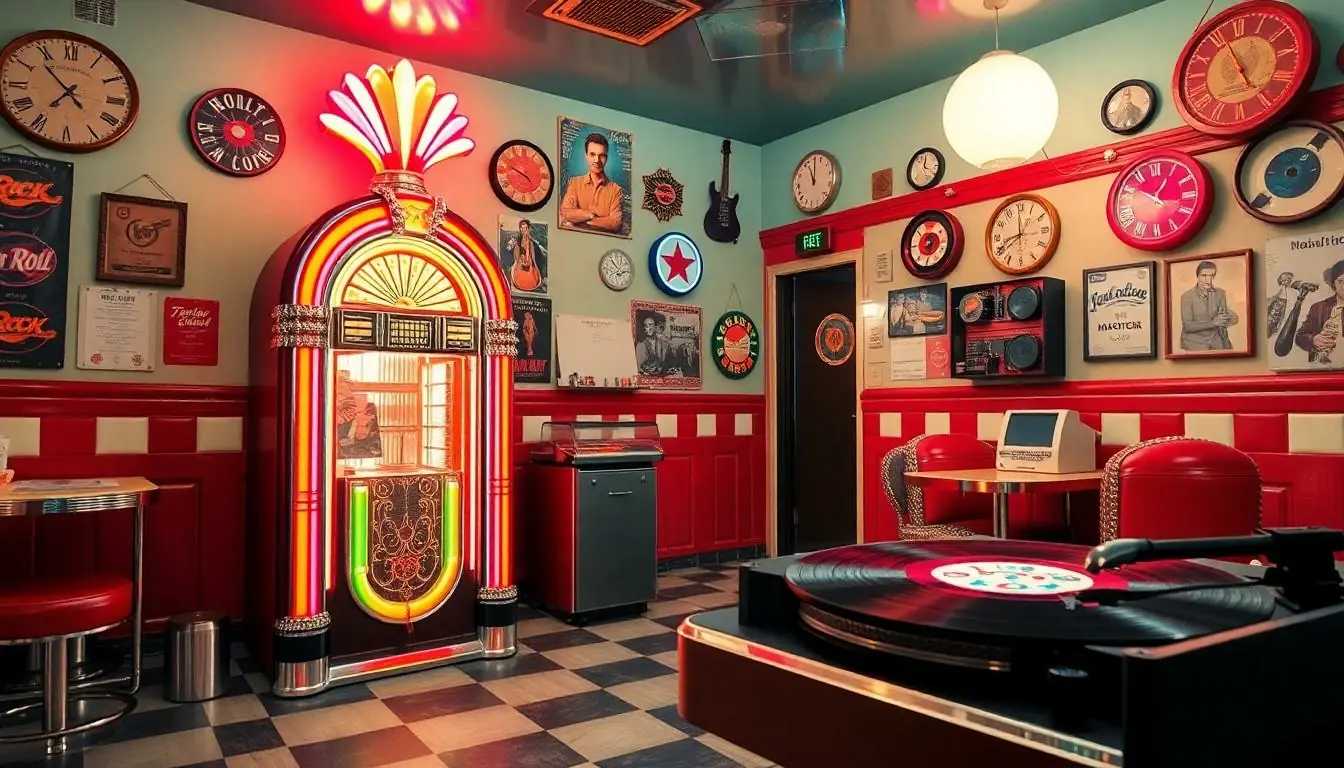Table of Contents
TogglePop music—it’s the soundtrack of life, from epic road trips to awkward dance-offs in the living room. But where did it all begin? This catchy genre didn’t just pop up overnight; it evolved through a rich tapestry of musical influences, cultural shifts, and a sprinkle of pure magic.
From the exuberant rhythms of early rock ‘n’ roll to the infectious hooks of today’s chart-toppers, pop music has a fascinating history that’s as colorful as a disco ball. It’s the genre that brought us everything from boy bands to bubblegum pop, and it’s time to dive deep into its origins. Buckle up, because this journey through time will reveal how pop music became the global phenomenon it is today, and why it continues to make us dance like no one’s watching.
The Origins of Pop Music
Pop music has roots intertwined with various musical styles, creating a rich historical tapestry. Understanding its origins requires examining the genres that influenced its development.
Early Influences and Genres
Early influences on pop music encompass rhythm and blues, jazz, rock ‘n’ roll, and folk. Rhythm and blues emerged in the 1940s, blending jazz and blues elements. This genre paved the way for future pop styles. Jazz also played a crucial role, with its improvisational techniques impacting song structures. Rock ‘n’ roll, which took center stage in the 1950s, combined these genres, creating a youthful sound that resonated widely. The folk revival in the 1960s introduced storytelling through music, influencing pop’s lyrical themes. Collectively, these genres shaped the foundation of what would become mainstream pop music.
Transition from Traditional to Popular Music
The transition from traditional to popular music marked a significant cultural shift. Traditional music often reflected regional or cultural identities, while popular music transcended geographical boundaries. The 1950s and 1960s witnessed this shift, as radio and television promoted accessible music. Artists like Elvis Presley revolutionized the industry, blending various genres to attract mass audiences. The development of technology, notably the cassette tape and later the CD, allowed artists to reach broader markets. This evolution fostered a new era where pop music could embrace diversity and innovation, appealing to a global fan base.
Key Historical Milestones

The history of pop music includes defining moments that shaped its sound and style. Key events mark the genre’s development, influencing artists and fans worldwide.
The Birth of Pop in the 1950s
Pop music emerged prominently in the 1950s, blending elements from various genres to create a unique sound. Artists like Elvis Presley and Buddy Holly captured audiences with catchy melodies and relatable lyrics. The combination of rhythm and blues with rock ‘n’ roll paved the way for mass appeal. Thanks to radio and television, pop music reached a broader audience, fostering a cultural shift. This era also saw the introduction of chord progressions and lyrical themes that resonated with the youth of the time. Fans embraced the new energy of pop, marking the beginning of its rise in the music industry.
The Evolution through the 1980s
The 1980s brought significant changes to pop music, driven by technological advancements and evolving cultural norms. Synthesizers and drum machines became staples, shaping the sound of the decade. Artists like Michael Jackson and Madonna revolutionized music videos, linking visuals with sound to enhance popularity. This era also featured the rise of diverse sub-genres, including new wave and dance-pop. Bold fashion and eclectic sounds characterized the period, influencing pop’s identity. Compelling themes in lyrics tackled social issues, reflecting the changing landscape of society. By the end of the 1980s, pop music solidified its status as a dominant force in the global music scene.
Cultural Impact of Pop Music
Pop music significantly influences society, shaping trends and cultural norms. Artists often mirror social issues and emotions through their lyrics, connecting with listeners on personal levels. The genre fosters community, as fans gather at concerts and festivals, sharing experiences that transcend geographical boundaries. Pop music also drives fashion, inspiring styles that reflect the latest hits and cultural attitudes.
Pop Music and Society
Pop music serves as a cultural reflection of societal values and changes. It addresses topics like love, identity, and social justice, inviting discussions that resonate with diverse audiences. During pivotal moments in history, songs often capture the public’s mood, providing a soundtrack to movements and generations. Top artists, including Billie Eilish and Taylor Swift, engage with fans through meaningful narratives that highlight common experiences. Each new hit can spark trends, influencing everything from language to lifestyle choices.
The Globalization of Pop Culture
Globalization has transformed pop music into a universal language that transcends borders. Artists from various cultures now collaborate, bringing diverse sounds and styles to mainstream audiences. Platforms like Spotify and YouTube enable listeners to explore international genres, expanding their tastes beyond local scenes. The popularity of K-pop, exemplified by groups like BTS and BLACKPINK, showcases how non-Western music captivates global fans. Moreover, these trends encourage cultural exchange, fostering appreciation for different artistic expressions.
Iconic Pop Artists and Their Contributions
Pop music features countless iconic artists whose contributions significantly shaped the genre. Each of these musicians brought unique sounds and styles, paving the way for future generations.
Pioneers of Pop Music
Elvis Presley revolutionized the music scene in the 1950s, blending rock ‘n’ roll with rhythm and blues. His charisma and catchy tunes captivated audiences, establishing a blueprint for pop artists. Buddy Holly followed with innovative songwriting and the introduction of the band format in pop music. His influence reached artists for decades, especially in the realm of melody and lyrics. The impact of Motown cannot be ignored. Artists like Diana Ross and the Supremes infused pop with soulful harmony, making the genre accessible to a wider audience. This legacy built the foundation for pop’s dynamic evolution.
Modern Pop Icons
Michael Jackson reigns as the King of Pop, driving global popularity through elaborate music videos and groundbreaking performances. Madonna, known as the Queen of Pop, transformed the music video landscape while exploring themes of identity and empowerment in her songs. Contemporary artists like Beyoncé blend pop with elements of R&B and hip-hop, pushing artistic boundaries and engaging fans. Taylor Swift has redefined storytelling in pop music with her autobiographical lyrics, connecting deeply with listeners across demographics. Billie Eilish introduces a fresh, introspective approach, resonating especially with younger generations. These artists ensure that pop music continues to evolve and thrive in the modern era.
The Future of Pop Music
Pop music continually evolves, reflecting changes in culture, technology, and audience preferences. It remains a vibrant force impacting global musical landscapes.
Trends and Innovations
Emerging trends significantly shape pop music’s future. Artists increasingly incorporate elements from various genres, blending pop with hip-hop, electronic, and even classical styles. Collaborations across different musical backgrounds foster innovation and diversity. Streaming platforms influence how music is consumed, leading to shorter song formats and the rise of viral hits. Social media plays a crucial role in promoting new artists and trends, generating instant global audiences. The integration of personal storytelling within lyrics resonates deeply with listeners, strengthening emotional connections.
The Role of Technology in Pop Music
Technology remains integral to the evolution of pop music. Digital tools enable artists to produce sophisticated sounds and experiment with new styles. Software for music production democratizes music creation, allowing aspiring musicians easy access to professional resources. Advancements in sound engineering enhance the clarity and quality of recordings. Virtual and augmented reality technologies offer immersive experiences at concerts or music festivals, transforming how fans engage with live performances. Additionally, algorithms used in streaming services personalize listener experiences, suggesting new tracks based on preferences. This technological landscape enhances pop music’s reach and relevance in today’s society.
Pop music’s journey from its roots to its current status as a global phenomenon showcases its remarkable adaptability and cultural significance. Its ability to reflect societal changes while connecting with diverse audiences ensures its continued relevance. As new artists emerge and technology evolves, pop music will likely keep pushing boundaries and exploring innovative sounds. This dynamic genre not only entertains but also inspires and unites people across the world, proving that its impact transcends mere entertainment. The future of pop music is bright and full of potential, promising to resonate with generations to come.





